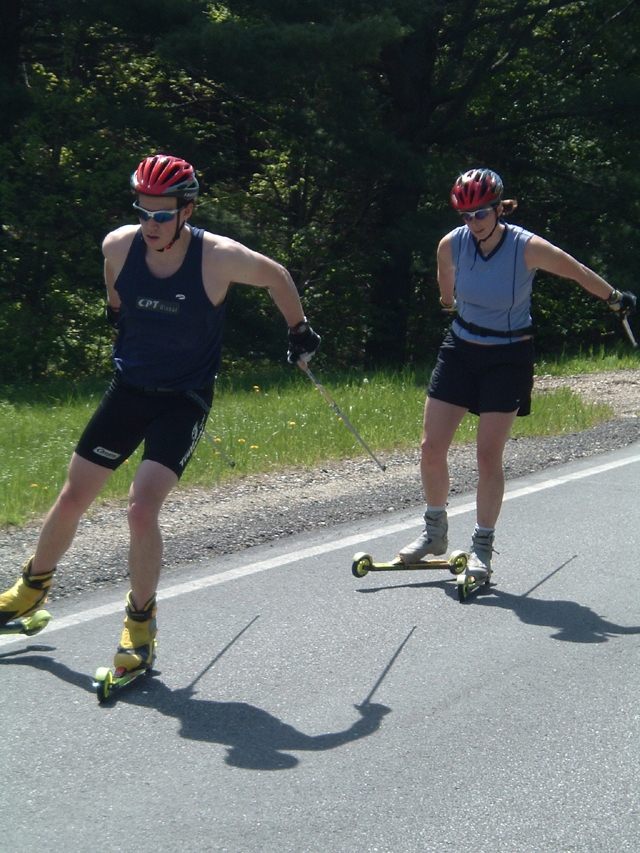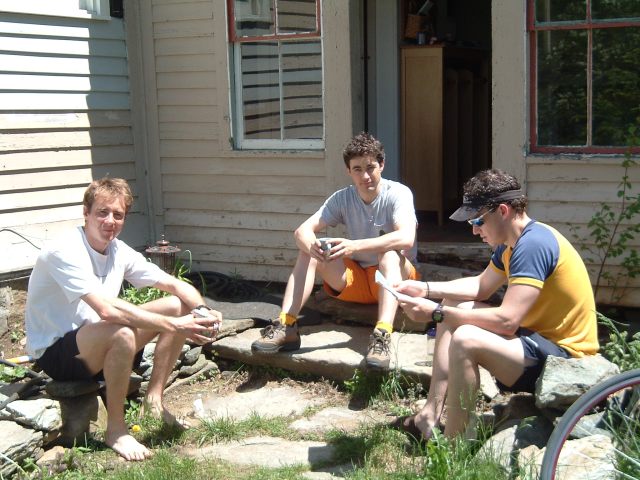The `Complete Fleet`: Notes on Ski Selection with help from Zach Caldwell.
By: Karl Saidla (2006/06/26)
Representatives of XC Ottawa made their yearly pilgrimage to visit Zach Caldwell of Caldwell Sport Specialties and Engineered Tuning (www.engineeredtuning.net) in West Townshend Vermont about a month ago. As usual, the trip proved to be both fun and very informative. I thought it might be worthwhile describing a few of the things we learned from Zach, who as many of you know already, is incredibly familiar with anything having to do with cross-country ski technology.
An article I wrote last year dealt mainly with the process of grinding skis, so this year I thought I might tell you a little bit about a subject that Zach knows plenty about and is a continuing mystery to many of us: selecting skis.
Last year was the first year that I worked with Zach on ski selection. His approach involves not only selecting good pairs of skis, but picking skis that are likely to work for your individual style of skiing and that also make sense from the point of view of having a complete and functional fleet (fleet-I love the use of this word for skis because it has such a military ring to it) of skis to get you through just about every condition with (relative) ease.
Obviously, the first step in the process is picking skis that are appropriate for you and that are going to perform well in the conditions that you want them to. While this subject is too lengthy to elaborate on here, it is well worth taking the time to find someone who knows how to do it, or to learn how to do it yourself. Some notes from Zach on the subject are provided at http://www.engineeredtuning.net/Flex.htm. You might also want to check out �The Complete Guide to Cross-Country Ski Preparation, by Nat Brown�, which has proved to be a useful resource for many people.
The second step, which I want to highlight in this article, is to pick skis that make sense from the perspective of your total �fleet�, as mentioned above. You not only should be thinking about what skis you need in order to cover all the likely conditions you will experience, but how the bases of the skis should be prepared with reference to the above. When you start adding things up matching skis to grinds and covering every condition becomes quite a complex activity. You might, for example, have a pair of skis that will cover a wide range of conditions from the point of view of flex, dictating a fairly universal type of grind. On the other hand, if you own three pairs of skis that have flex characteristics of broad ranges, you might choose to designate a couple of these pairs of skis for more specific conditions and, accordingly, adjust your choice of grind. Anybody starting to feel queasy as you consider the skis you currently own, what they are suited for, and how they are ground (or not ground and left lying in your basement covered in dog hair)?
Here is where someone like Zach comes to the rescue. An examination of my current fleet of skis, for instance, revealed that while I had good skis for many conditions, there were a couple areas of weakness. In skating, I did not have any skis that were particularly well-suited to wet conditions. In classic, I had nothing particularly well suited to klister. In my case, the answer was relatively simple - select a couple of pairs with flex characteristics matching wet conditions, and then apply an appropriate wet snow grind. The answers, however, are not always so simple. What happens, for instance, when you have a pair of skis that you love to use in slushy saturated snow, but they also work well at temperatures as far down as �5C. What kind of grind do you go with? Another question might be are these skis really as good as you think they are for the conditions you are talking about? Perhaps your current �wet snow� skis are better than anything else you own, so you use them in just about every wet and semi-wet condition that occurs. You might find out from an expert that what you have is ideal for slush, and merely o.k. for some other stuff. In this case you might grind that pair with a wet-slush oriented grind, and buy a better pair for the slightly less sloppy conditions.
The goal is to wind up with a situation where you know exactly what skis are good for what conditions, and you have something for virtually every type of condition.
This brings us to the final important point that I intended to highlight. You probably don�t need as many pairs of skis as you might think. For instance, according to Zach, it is possible to have as few as two to three pairs of classic skis and expect to have reasonable skis in most conditions. The key is knowing which pair is going to work when, and waxing/structuring them accordingly. The point is not to have 20 pairs of skis and confuse yourself, but rather, to have a few pairs that are actually good and that can get you through the vast majority of the situations you will encounter.
It can be very refreshing to
show up on a race morning, and after a cursory examination of the conditions
be able to say with some confidence that you will be racing with pair
of skis A today. The choice is easy when your skis are good, you
have a well thought out �fleet� of skis, and you know them well.
To sum up, there were three key aspects of ski selection that I thought would be worth highlighting in this article. Namely, these are ...
- Either learn the fundamentals of picking good skis yourself, or find someone who does. Skis are expensive, but close to totally useless for high level racing if they are not well selected.
- Think of your skis in terms of how they relate to the other pairs of skis you own. Work on setting up an a �fleet�of skis intelligently. This includes not only picking the right skis, but preparing the bases accordingly, either by grinding or by hand.
- Keep things as simple as possible. For most of us, having a few less pairs of skis is actually easier. We don�t after all, have a staff to look after our equipment. Beyond a certain point, having more equipment is just a pain.

Andrew and Megan getting in some training.

Karl, Zach and Andrew discussing skis and drinking coffee.


